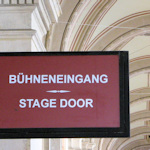
Ask about the world’s best opera venues and most people mention the Wiener Staatsoper (Vienna State Opera House) in the same breath as Paris or New York…
- Opened in 1869, partly rebuilt post-WWII
- Gorgeous interiors & top opera stars
- Performances change daily
- Also home to ballet & the Opernball
- Affordable (especially standing space)
- A stop on the Hop on Hop off tours
- Book a concert experience* for your trip
- See also:
The State Opera House
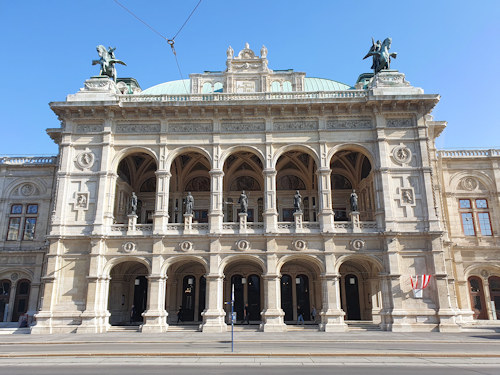
(The main entrance)
The front of the Staatsoper looks out onto Vienna’s Ringstraßen boulevard, but relatively wide streets and open spaces surround the other sides, too.
This standalone location gives the building a notable presence in Vienna’s city centre, like a grand diva towering above the orchestra pit. I often use it as a reference to guide people to other locations.
This presence feels entirely deserved given the Staatsoper’s status in the world of opera, invariably appearing in all sorts of top 10 lists.
A brief history
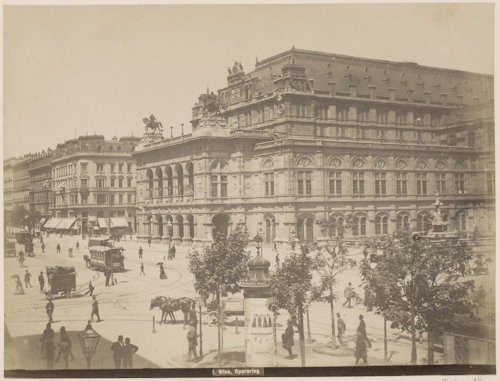
(The freshly-built Staatsoper in the late 19th century. Photo courtesy of the Rijksmuseum. See more historical photos of Vienna)
The opera house greeted its first visitors in 1869 as the Hofoper (court opera) for a performance of Mozart’s Don Giovanni.
Like many of Vienna’s landmarks, the building owes its existence to the removal of the city fortifications in the mid-19th century and the opening up for construction of the park-like Glacis area that kept the suburbs at bay.
Architect August von Sicardsburg (1813-1868) designed the basic Renaissance-style building, while Eduard van der Nüll (1812-1868) took care of the interior décor.
The public reaction at the time was broadly negative, and this criticism likely contributed to the untimely death of both architects before the official opening.
(Staatsoper auditorium photographed around 1940 by Martin Gerlach jun., Wien Museum Inv.-Nr. 211273, reproduced with permission under the terms of the CC0 licence)
However, a newspaper article just days after that opening offered a robust defence of the two mens’ work, blaming Viennese pessimism and the population’s love of mockery and grumbling for the bad press. It stated (my translation):
The interior is such that the new opera house is perhaps the most beautiful theatre in Europe.
Unfortunately, the original building failed to escape the ravages of WWII, with allied bombs destroying large parts of it in 1945.
The rebuilding work took around ten years, with Beethoven’s Fidelio welcoming audiences at the reopening in 1955.
Today’s opera house looks especially fantastic at night (see the photo later in the article). The interior is, as that 19th-century writer remarked, quite gorgeous.
If you don’t attend a performance, I recommend the in-house tour that takes you through the building and out behind the surprisingly large stage. Some areas are actually fully original in their historical glory; the wonderful main staircase, for example, survived the aerial bombing intact.
Callas and Cruise
As noted earlier, the Staatsoper sits at the high table of world culture. The playing schedule varies daily, so you won”t find continuous runs of any one particular production.
Puccini’s Madame Butterfly might pine for a lost lover on Thursday, Strauss’s Salome do the dance of the seven veils on Friday, and Bottom make an ass of himself on Saturday in Britten’s A Midsummer Night’s Dream.
Not to mention the occasional ballet thrown in for good measure: the Staatsoper opera also houses the Vienna State Ballet.
And the institution has a second location in the Künstlerhaus dedicated to productions for children, young adults, and families.
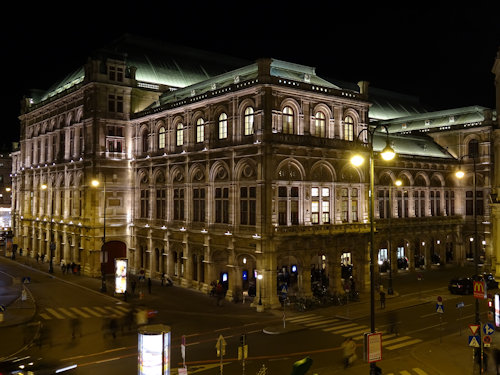
(The raised area next to the Albertina Museum make an ideal spot for taking photos of the Staatsoper)
Around 200 stagehands, vast numbers of costumes, swathes of scenery, and a whole lot of storage space combine to ensure Staatsoper sets can be switched in and out quickly, as required by the changing performance.
A permanent in-house ensemble also helps make such a dynamic schedule possible.
Guest performers, conductors, directors and others from the crème de la crème of the operatic universe complement the Staatsoper’s own team for selected productions.
Claudio Abbado, Luciano Pavarotti , Maria Callas, Enrico Caruso, Joan Sutherland, Anna Netrebko, Montserrat Caballé, Plácido Domingo, Gustav Mahler, José Carreras, Elisabeth Schwarzkopf, Riccardo Muti, and Herbert von Karajan are just some of the names who’ve worked at (or with) the Staatsoper.
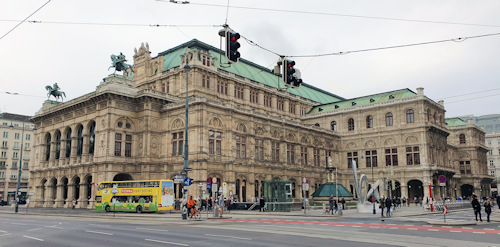
(Unusually traffic-free side view from the road)
It’s not just the prestigious operatic history that contributes to the opera house’s fame.
The Staatsoper hosts the world-famous Opernball (Vienna Opera Ball) in February, for example, and it even played a central role in one of the Mission Impossible films.
So if anyone asks you what connects Callas and Cruise, you now have the answer.
You can spot the building in other productions, too, like the Jack Ryan TV series, the The Recruit TV series, or the Sachertorte and The Woman in Gold movies.
Tickets & alternatives
See my advice on getting tickets, including the inexpensive option of standing space, where a night at the opera can cost little more than a morning coffee.
Incidentally, every seat and standing place inside has its own small screen displaying subtitles for the opera in question, with a choice of languages (including English and German, of course).
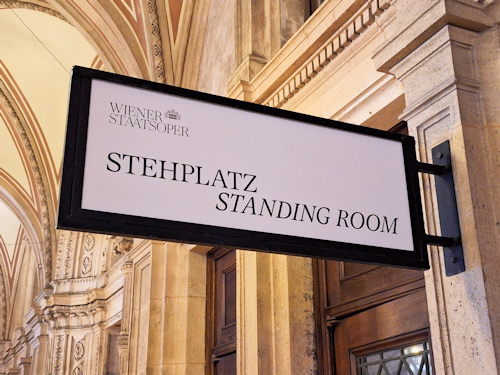
(This way for cheap standing tickets)
Aside from a ticket or tour, you have a couple of other ways to experience the joys of the building or Viennese opera in general:
- The Staatsoper offers a live streaming service with broadcasts of occasional performances or events
- Many historical venues put on special visitor-friendly concerts featuring better-known light classical music and select operatic pieces
- Google features the Vienna State Opera in its Arts & Culture project
- Vienna has two other major opera houses: the Volksoper and the Theater an der Wien
How to get to the Staatsoper
You probably pass the Staatsoper on your travels around the city centre; it actually marks the start of my suggested walking tour of Vienna.
The building’s a short walk from the pedestrianised centre: just wander up Kärntner Straße from Stephansdom cathedral, for example. If you want accommodation close by, then here are some suggestions.
Subway: the Oper exit from Karlsplatz subway station drops you pretty much at the doorstep. Karlsplatz is on the U1, U2 and U4 subway lines. Alternatively, the very central Stephansplatz station (U1 and U3) is just up the road, too.
Tram/bus: there’s a tram stop opposite (Oper/Karlsplatz), served by the 1, 2, D, 71 and 62 trams. Or take the 2A city centre bus to Kärntner Straße.
Address: Opernring 2, 1010 Vienna | Website
